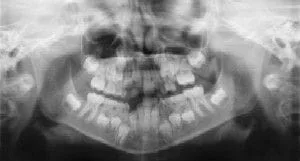Dental Radiographs (X-Rays)

Radiographs (X-Rays) are a vital and necessary part of your child’s dental diagnostic process. Without them, certain dental conditions can and will be missed.
Radiographs detect much more than cavities. For example, radiographs may be needed to survey erupting teeth, diagnose bone diseases, evaluate the results of an injury, or plan orthodontic treatment. Radiographs allow dentists to diagnose and treat health conditions that cannot be detected during a visual clinical examination. If dental problems are found and treated early, dental care is more comfortable for your child and more affordable for you.
The American Academy of Pediatric Dentistry recommends radiographs and examinations every six (6) months for children with a high risk of tooth decay. On average, most pediatric dentists request bitewing radiographs approximately once a year. Approximately every three (3) years, it is a good idea to obtain a complete set of radiographs, which includes either a panoramic radiograph and bitewings or multiple periapical radiographs and bitewings.
Pediatric dentists are particularly careful to minimize the exposure of their patients to radiation. With contemporary safeguards, and reliable, high quality radiographic equipment the amount of radiation received in a dental X-ray examination is extremely small. The risk is negligible. In fact, the dental radiographs represent a far smaller risk than an undetected and untreated dental problem. Lead body aprons and shields will protect your child. Today’s equipment filters out unnecessary x-rays and restricts the x-ray beam to the area of interest. Digital radiography assures that your child receives a minimal amount of radiation exposure.
For more information concerning pediatric dentistry, please visit the website for the
American Academy of Pediatric Dentistry.
At What Age are Radiographs Taken?
Dr. West may recommend taking x-rays around the age of two or three (2 or 3). For young children this involves “pictures” of the upper and lower front teeth. This is a simple procedure, the radiographic film is placed between the upper and lower front teeth as if they were biting on a cracker. On future visits, once the back teeth touch one another “bitewing” radiographs will be taken to inspect the surfaces that are touching. If a child is at high risk for tooth decay, or has experienced dental trauma, x-rays may be taken at an earlier age. Selected x-rays are taken on a yearly basis to aid in a complete and accurate oral health evaluation.



